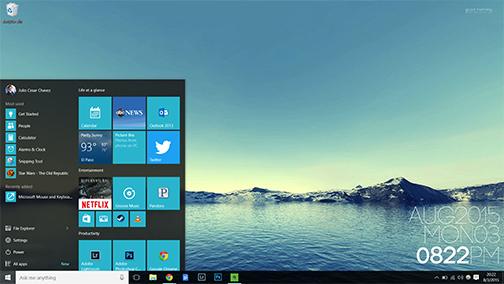Microsoft released Windows 10 July 29 as a free upgrade for all Windows 7 and 8 customers. The new operating system marks the return of the long-lost start menu, a feature noticeably replaced in Windows 8 with the touch-optimized start screen. It is also the beginning of Microsoft’s goal to have everything connected through one OS, with features like Cortana, the digital assistant.
Should you upgrade right away? It depends on what you like about your current version of Windows, and how Windows 10 keeps, gets rid of or improves those features.
Windows 10 might be Microsoft’s last big OS release, as they’ve said they want to just keep it regularly updated and use it as a universal system throughout all of their computers, tablets and phones.
The update requirements are only a few gigabytes of memory. It has the same system requirements as Windows 7, so if your computer can run 7 comfortably, it should have no problem with 10. A great majority of programs will also run on 10, and since the OS update is treated as an update rather than a clean install you won’t have to re-install any apps unless you want to.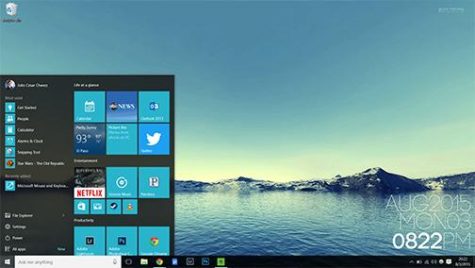
The return of the start menu:
The start menu is back, and it brings part of the start screen with it. By opening the menu you’ll see the traditional listing of programs on the left-hand side, but just one column over is a collection of Live Tiles, the shortcuts to programs and apps used in the Windows 8 start screen.
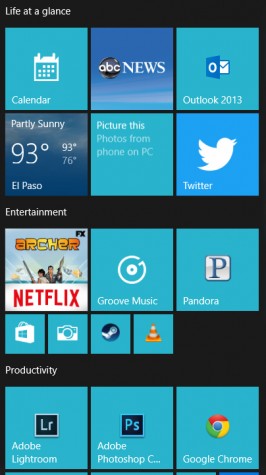 Live tiles offer a way to check out basic updates from your apps without having to open them. Since the start menu offers a way to access all of your programs, you can reserve the Live Tile spaces for your favorite apps and those you use most often.
Live tiles offer a way to check out basic updates from your apps without having to open them. Since the start menu offers a way to access all of your programs, you can reserve the Live Tile spaces for your favorite apps and those you use most often.
Another feature carried over from Windows 8 is the simplified search function. If you don’t want to scour your computer with Explorer looking for a certain program or file, you can simply press the Windows button and start typing the name of what you’re looking for.
Cortana (the digital assistant, not the artificial intelligence)
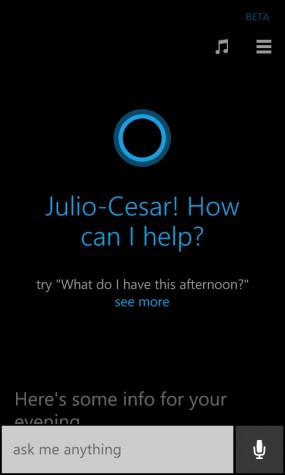 If you happen to be part of the 3 percent of smartphone users with a Windows phone, you already know Cortana. For those of you who don’t, Cortana is Microsoft’s answer to Siri and Google Now. No longer confined to the small number of Windows phone users, Cortana has been ported into Windows 10.
If you happen to be part of the 3 percent of smartphone users with a Windows phone, you already know Cortana. For those of you who don’t, Cortana is Microsoft’s answer to Siri and Google Now. No longer confined to the small number of Windows phone users, Cortana has been ported into Windows 10.
Like any good personal assistant, Cortana is designed to give you a look at your day, presenting weather, traffic and calendar information for you to get started on your day.
Cortana can remember your preferences, and if you use the built-in mail app (or install Outlook, since Office is free to UTEP students), she can track scheduling information in your emails to set up a personal calendar. You can also ask her to look up stuff online, although she automatically uses Bing. You can fix this setback by setting Chrome as your default browser and downloading the Bing2Google extension.
Cortana is not perfect; sometimes it will misunderstand what you’re saying, and is limited to using built-in apps.
You also can’t connect it to any accounts right now, so anything you do will be limited to the local system on your computer. You are given the choice of connecting it to your Office 365 account, the same account you use for university work, but you will only get a return error when you try to pair it. As of now, you also don’t have the option to connect it to your Google or iCloud account, which would connect the calendar and contacts to your phone. Hopefully this issue will be fixed in the coming weeks.
What if you liked the Windows 8 start screen?
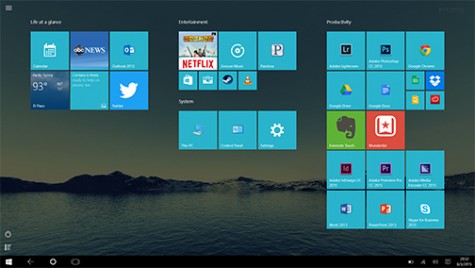 For those who liked the Windows 8 start screen, Microsoft did not forget about you. There is the tablet mode function, which returns your machine to a touch-oriented layout. Tablet mode will use the same Live Tiles that you have set up in your start menu. Users with a 2-in-1 computer like the Surface Pro 3 can find a setting that will automatically change the start menu to a start screen when the computer detects it will be used as a tablet.
For those who liked the Windows 8 start screen, Microsoft did not forget about you. There is the tablet mode function, which returns your machine to a touch-oriented layout. Tablet mode will use the same Live Tiles that you have set up in your start menu. Users with a 2-in-1 computer like the Surface Pro 3 can find a setting that will automatically change the start menu to a start screen when the computer detects it will be used as a tablet.
Edge, Microsoft’s new Internet browser
One of the new features brought to Windows 10 is Edge. It is a great improvement on the archaic Internet Explorer, and even beats Chrome and Firefox in speed. It feels more organic than the two most popular browsers.
Edge also lets you annotate websites themselves for your own use, or you can share your notes with friends through OneNote.
The main downside to Edge is the same reason it is so fast: it has no extensions–at least not yet. Extension support will be started in the coming months, after all the kinks are ironed out. Until then, Chrome and Firefox will serve those who absolutely need extensions. For simple web browsing, Edge is more than enough.
The Age of (stealing) Information
Privacy is a topic on many people’s minds after the revelation of the NSA’s PRISM domestic spying program, and for some, Windows 10 may be a big violator of that privacy. If you use the default setup, Microsoft will have access to all the documents in your indexed folders (My Documents, My Pictures). This access is understandable for those who want Cortana to be highly personalized and to really know them.
To some, this level of personalization is not worth giving Microsoft access to so many local files. Using a custom setup right after you first upgrade can easily turn off the privacy settings. The custom setup does not take much longer than the default; it is only about five minutes of checking off boxes. Keep in mind; if you turn everything off during your setup, you will not be able to use Cortana. The privacy settings needed to use Cortana are not that extensive, and can be turned on without setting your personal privacy at risk.
Overall, the new OS is a great improvement on Windows 8. It provides a good balance of the good features from the previous OS with the comfortable familiarity of the Windows most of us grew up with, but it does have its downsides when it comes to privacy. Windows 10 gets a 9 out of 10.
For those of you wondering why Microsoft went with Windows 10 instead of 9, the answer is the same reason Windows Vista is afraid of Windows 7: because 7 ate 9.
In reality, Windows 9 would have created compatibility problems since it began with the number nine, like Windows 95 and 98.
Julio Cesar-Chavez may be reached at [email protected].


